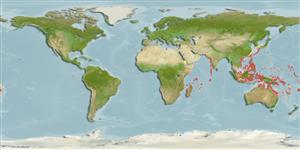Teleostei (teleosts) >
Gobiiformes (Gobies) >
Gobiidae (Gobies) > Gobiinae
Etymology: Amblygobius: Greek, amblys = darkness + Latin gobius = gudgeon (Ref. 45335).
More on author: Valenciennes.
Environment: milieu / climate zone / depth range / distribution range
Ecology
Marine; brackish; reef-associated; depth range 1 - 20 m (Ref. 90102). Tropical
Indo-West Pacific: Red Sea south to Maputo Bay, Mozambique, eastward to Micronesia (Ref. 4343).
Size / Weight / Age
Maturity: Lm ? range ? - ? cm
Max length : 18.0 cm TL male/unsexed; (Ref. 2798)
Dorsal spines (total): 7; Dorsal soft rays (total): 13 - 15; Anal spines: 1; Anal soft rays: 13 - 15. Characterized by yellowish brown body color grading to white ventrally; presence of 5-6 dark brown bars with white markings in between on side of body; upper back with a row of small widely spaced black spots; first and second dorsal fin equal in height; rounded caudal fin; longitudinal scale series 55; ctenoid body scales; cycloid scales on nape, abdomen, and breast; predorsal scales extending to interorbital space; scales dorsally on opercle, absent on cheek; depth of body 3.6-4.0 in SL (Ref. 90102).
Solitary or in pairs (Ref. 90102). Occurs on sandy or sparse seagrass substrata of protected reefs. Hovers just above the bottom and takes refuge in a burrow, Ref. 48637.
Life cycle and mating behavior
Maturities | Reproduction | Spawnings | Egg(s) | Fecundities | Larvae
Randall, J.E., G.R. Allen and R.C. Steene, 1990. Fishes of the Great Barrier Reef and Coral Sea. University of Hawaii Press, Honolulu, Hawaii. 506 p. (Ref. 2334)
IUCN Red List Status (Ref. 130435)
Threat to humans
Harmless
Human uses
Fisheries: minor commercial; aquarium: commercial
Tools
Special reports
Download XML
Internet sources
Estimates based on models
Preferred temperature (Ref.
123201): 24.9 - 29.3, mean 28.3 °C (based on 2251 cells).
Phylogenetic diversity index (Ref.
82804): PD
50 = 0.5000 [Uniqueness, from 0.5 = low to 2.0 = high].
Bayesian length-weight: a=0.01023 (0.00477 - 0.02194), b=3.02 (2.84 - 3.20), in cm total length, based on LWR estimates for this (Sub)family-body shape (Ref.
93245).
Trophic level (Ref.
69278): 3.0 ±0.2 se; based on size and trophs of closest relatives
Resilience (Ref.
120179): Medium, minimum population doubling time 1.4 - 4.4 years (Preliminary K or Fecundity.).
Fishing Vulnerability (Ref.
59153): Low vulnerability (10 of 100).
Nutrients (Ref.
124155): Calcium = 74.2 [39.8, 144.1] mg/100g; Iron = 0.639 [0.324, 1.122] mg/100g; Protein = 19 [17, 21] %; Omega3 = 0.149 [0.069, 0.261] g/100g; Selenium = 20.1 [10.7, 40.9] μg/100g; VitaminA = 115 [32, 378] μg/100g; Zinc = 1.73 [1.19, 2.49] mg/100g (wet weight);
